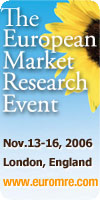European Market Research Event – Day 2, morning
James Surowiecki, author of “The Wisdom of Crowds”
James Surowiecki is an extremely well-skilled public speaker. He managed to give a detailed and well-structured 45 minute presentation on his book “The Wisdom of Crowds” with many examples, without notes and without slides.
His argument is that crowds are often smarter collectively than even the smartest individuals it contains. He claims that “If you can figure out ways to tap into the collective intelligence of your organisation and the collective intelligence of your consumers, you can radically change your capability to resolve problems and to forecast the future.”
Surowiecki gave many examples of how that is being done:
- NASA using volunteers to classify Martian craters in a programme called Clickworkers,
- Iowa Electronic Markets: the use of markets to predict elections. People buy and sell shares to predict the outcome of US Presidential elections. They were more accurate 3/4 of the time than any Gallup poll.
- Hollywood Stock Exchange. People buy and sell shares in how well movie releases will do. They give a better answer than any other method. They also picked 7 out of 8 of the major Oscar winners.
- Other examples include HP where employees could buy or sell shares in how well printer sales were going to do, and it outperformed internal forecasts. Siemens also used this technique to predict how long a particular software product development is going to take. Microsoft has also done something similar, and Google has launched PROPHET, which predicts 200 events of all kinds and they have been almost perfectly correct.
But crowds only act intelligent under three conditions:
- Aggregation. It is about the aggregate judgment of lots of individuals, not about consensus.
- Diversity. The crowd, the group is cognitively diverse with differences of perspective and differences of heuristics. Homogeneous groups tend to reinforce their own thinking. Diversity mitigates this effects of peer pressure, which can be very powerful.
- Independence. The people within the crowd act independently. They think for themselves and rely on their own information, own ideas. Our natural tendency to imitate and protect our reputation can move us away from this independence.
According to Surowiecki, one of the implications for market research is that you want to ask people not what they think of a product, but instead you want to ask the question: “how successful do you think this product is going to be” or “how many people do you think will buy this product by February”.
Roula Nasser, P&G
Roula Nasser is Director of Customer and Market Knowledge of the Global P&G Beauty.
Her talk, entitled “Driving Consumer & Market Understanding to New Heights: A Roadmap for Success” set out a market strategy and vision, but was unfortunately a bit weak on examples.
P&G has put a lot of emphasis on focusing on the future, or in their own jargon: from hindsight, to insight, to foresight. To do that, they have been investing a lot on new capabilities to get at consumer attitudes; on understanding the changing dynamics of the marketplace, particularly the differences between the developed and the developing world; and on making research and researchers strategic.
Nasser then went on to say how important it is to have visible support from company leaders, and went into a long and elaborate praise of A.G. Lafley who is P&G’s chairman, president and CEO.
Lastly, she stressed how important it is to think about consumers in new ways, by seeing them as people and developing a more personal relationship, and to use more involved shadowing techniques, which they call “Walk with Me”: go and visit people in their homes; live on the budget of a low-income consumer for a week; shop with consumer’s grocery list, budget and children; serve in jobs where P&G products are used.
The examples, from China and South Africa, illustrated how such an approach can lead to real benefits for advertising. There were however no examples of what this deeper people-centred approach might mean for P&G’s product innovation.





[…] Il secondo giorno dell’evento ha ospitato nella mattina interessanti interventi di seguito citati.James Surowiecki, autore di “La saggezza della folla“, libro in cui sostiene, date certe condizioni, la superiorità dell’intelligenza collettiva su quella del singolo. […]
radio publicity…
For more book recommendations, see the book recommendation page Techcrunch An error has occurred; the feed is probably down. Try again later. Startup Spark Social networking is great for business– if you do it right! Is your home office working for y…